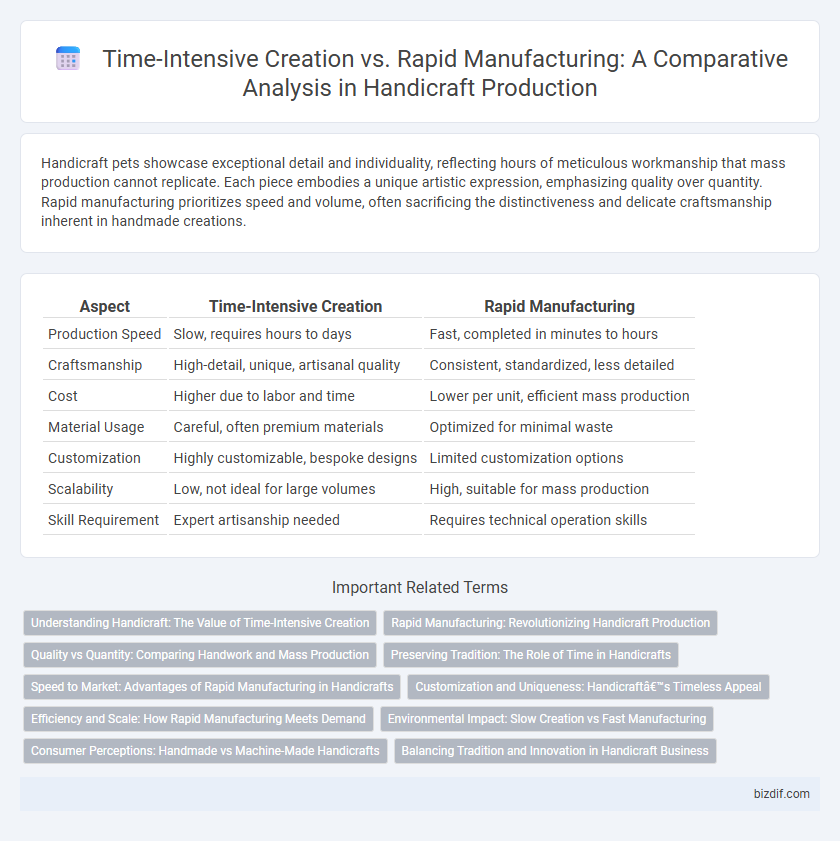Handicraft pets showcase exceptional detail and individuality, reflecting hours of meticulous workmanship that mass production cannot replicate. Each piece embodies a unique artistic expression, emphasizing quality over quantity. Rapid manufacturing prioritizes speed and volume, often sacrificing the distinctiveness and delicate craftsmanship inherent in handmade creations.
Table of Comparison
| Aspect | Time-Intensive Creation | Rapid Manufacturing |
|---|---|---|
| Production Speed | Slow, requires hours to days | Fast, completed in minutes to hours |
| Craftsmanship | High-detail, unique, artisanal quality | Consistent, standardized, less detailed |
| Cost | Higher due to labor and time | Lower per unit, efficient mass production |
| Material Usage | Careful, often premium materials | Optimized for minimal waste |
| Customization | Highly customizable, bespoke designs | Limited customization options |
| Scalability | Low, not ideal for large volumes | High, suitable for mass production |
| Skill Requirement | Expert artisanship needed | Requires technical operation skills |
Understanding Handicraft: The Value of Time-Intensive Creation
Handicraft emphasizes meticulous attention to detail and skilled artistry, resulting in unique, high-quality products that embody cultural heritage and personal expression. The time-intensive creation process allows artisans to infuse each piece with authenticity and durability, contrasting sharply with rapid manufacturing's mass-produced, often less distinctive items. Understanding the value of time in handicraft highlights the importance of preserving traditional techniques and supporting sustainable, artisanal economies.
Rapid Manufacturing: Revolutionizing Handicraft Production
Rapid manufacturing is transforming handicraft production by significantly reducing the time required to create intricate designs while maintaining high-quality standards. Advanced technologies like 3D printing and CNC machining enable artisans to produce complex pieces with precision and consistency, bypassing traditional time-intensive methods. This innovation allows for faster market response and scalability, reshaping the handicraft industry with efficiency and modernity.
Quality vs Quantity: Comparing Handwork and Mass Production
Handicraft emphasizes meticulous attention to detail, resulting in unique, high-quality products that often take hours or days to complete. Rapid manufacturing prioritizes speed and volume, enabling mass production but sometimes compromising on craftsmanship and durability. The balance between artisanal quality and quantity depends on consumer values and market demands for authenticity versus accessibility.
Preserving Tradition: The Role of Time in Handicrafts
Handicraft creation requires significant time investment to preserve intricate techniques passed down through generations, ensuring cultural heritage remains intact. Unlike rapid manufacturing, which prioritizes speed and mass production, time-intensive handicrafts emphasize quality, authenticity, and artisanal skill. This deliberate pace safeguards traditional craftsmanship, maintaining unique artistic expressions that reflect historical and regional identities.
Speed to Market: Advantages of Rapid Manufacturing in Handicrafts
Rapid manufacturing accelerates the speed to market by enabling quicker production cycles compared to traditional time-intensive handicraft creation. Utilizing technologies like 3D printing and CNC machining allows artisans to produce high-quality items efficiently, meeting consumer demand faster. This speed advantage supports real-time customization and shorter lead times, crucial for competitive markets in the handicraft industry.
Customization and Uniqueness: Handicraft’s Timeless Appeal
Handicraft offers unparalleled customization and uniqueness, with artisans investing significant time and skill to create one-of-a-kind pieces that reflect cultural heritage and personal expression. Unlike rapid manufacturing, which prioritizes mass production and uniformity, handicrafts emphasize individuality and intricate detail, resulting in products that carry emotional and artistic value. This time-intensive process preserves traditional techniques, ensuring each item's authenticity and timeless appeal in a world dominated by fast consumerism.
Efficiency and Scale: How Rapid Manufacturing Meets Demand
Rapid manufacturing leverages automation and advanced technologies to achieve high efficiency and scalable production, meeting large market demands quickly. Unlike time-intensive handicraft processes, rapid manufacturing reduces production cycles and minimizes labor costs, enabling faster turnaround times. This efficiency allows businesses to respond swiftly to consumer trends without compromising on product availability or quality.
Environmental Impact: Slow Creation vs Fast Manufacturing
Handicraft production emphasizes time-intensive creation, which typically results in lower environmental impact due to minimal energy consumption and reduced waste generation compared to rapid manufacturing. Fast manufacturing processes often rely on mass production techniques that consume significant resources and contribute to pollution and carbon emissions. Slow creation promotes sustainable practices by prioritizing quality over quantity, thereby supporting eco-friendly consumption patterns.
Consumer Perceptions: Handmade vs Machine-Made Handicrafts
Handmade handicrafts often carry a perception of higher quality and uniqueness due to their time-intensive creation, attracting consumers valuing authenticity and artisanal skill. Machine-made products cater to faster production and affordability but may be viewed as lacking the personal touch and cultural richness of handcrafted items. Consumer preferences increasingly reflect an appreciation for the narrative and craftsmanship behind handmade goods, influencing market demand despite higher costs.
Balancing Tradition and Innovation in Handicraft Business
Handicraft businesses face the challenge of balancing time-intensive creation with rapid manufacturing by integrating traditional techniques with modern technology to enhance efficiency without compromising quality. Emphasizing craftsmanship preserves cultural heritage while adopting innovative tools accelerates production and meets market demand. Strategic use of digital platforms and automation supports scalability while maintaining the artisanal value crucial for brand identity and customer loyalty.
Time-intensive creation vs Rapid manufacturing Infographic

 bizdif.com
bizdif.com